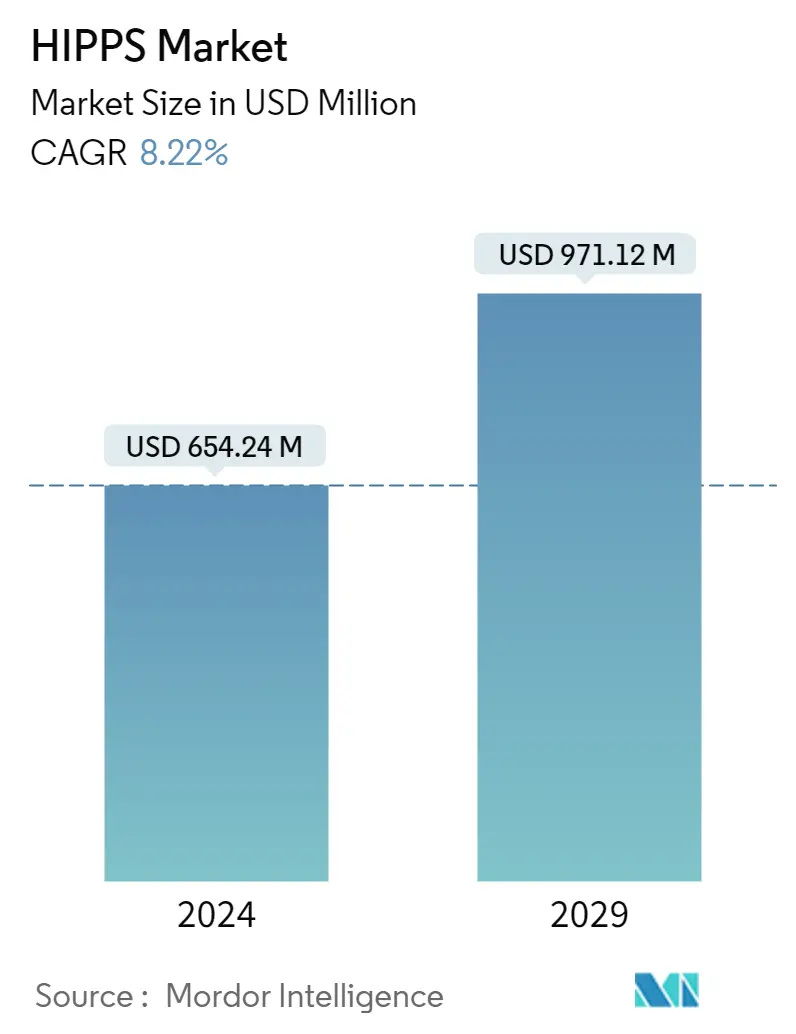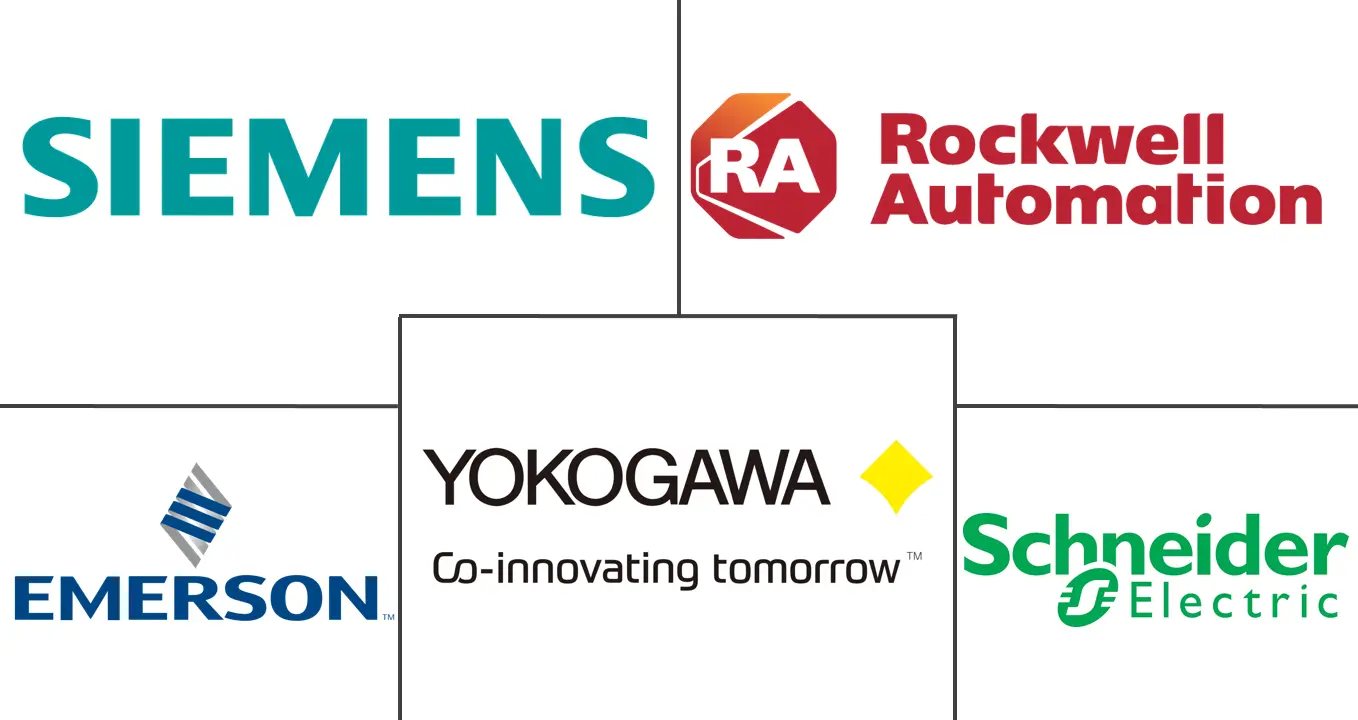Market Size of HIPPS Industry

| Study Period | 2019 - 2029 |
| Market Size (2024) | USD 654.24 Million |
| Market Size (2029) | USD 971.12 Million |
| CAGR (2024 - 2029) | 8.22 % |
| Fastest Growing Market | Asia Pacific |
| Largest Market | Asia Pacific |
Major Players
*Disclaimer: Major Players sorted in no particular order |
High Integrity Pressure Protection System Market Analysis
The HIPPS Market size is estimated at USD 654.24 million in 2024, and is expected to reach USD 971.12 million by 2029, growing at a CAGR of 8.22% during the forecast period (2024-2029).
Oil and gas are one of the significant target segments for the high integrity pressure protection system (HIPPS) market. With the recent outbreak, the industry has observed a downward trend, affecting market growth. From the demand perspective, oil and gas have been challenged by the effects of the COVID-19 outbreak. Owing to this, producers have rapidly slashed capital spending and drilling programs. The pandemic has impacted the progress of several projects, resulting in pipelines getting stalled or delayed.
- The connection of new gas production sources to a gas plant facility has often required mechanical relief devices to protect gas production facilities or pipelines. New production sources connected to existing pipelines require the pipeline to be protected against potential overpressure, resulting in the release of hydrocarbons to the atmosphere or undesirable burning of these hydrocarbons via a flare system. Rising government regulatory standards to defend safety and security at industrial plants due to increasing accidents at plants drives the growth of the market.
- Strict government regulations in the regions on emission levels across industries to increase workstation safety have bolstered the demand for various HIPPS applications. Due to rapid developments in the emerging markets, sustainability policies, the rise of new technologies, and changing consumer preferences, the end-user industry landscape has been rapidly evolving.
- In July 2020, in a boiler blast at Neyveli Thermal Power Station (India), at least six people died, and as many as 17 others suffered serious injuries. This was the second boiler explosion in two months at the same plant. It is suspected that overheating and high pressure led to the power plant explosion in Tamil Nadu (India).
- Players operating in the market studied have been focusing on cutting-edge technology developments pertaining to HIPPS applications. For instance, in December 2019, High-Pressure Equipment Company (a subsidiary of Graco Inc.) introduced a new soft seat relief valve designed to protect liquid and gas tubing systems from overpressure damage and failure. The new relief valves are available in pressure ranges from 1,500 to 25,000 psi for 9/16' O.D. tubing, with adapters available for other sizes. The company's newly developed valves are factory set to the designated pressure and tagged accordingly. They feature 316 stainless steel bodies and removable seat glands, with a 17-4PH stem and seal ring for standard applications.
High Integrity Pressure Protection System Industry Segmentation
HIPPS are applied to prevent the over-pressurization of a plant by shutting-off the source of the high pressure. In traditional systems, over-pressure is dealt with relief systems. Relief systems have obvious disadvantages, such as the release of flammable and toxic process fluids in the environment and often a large footprint of the installation. With increasing environmental awareness, relief systems are no longer acceptable solutions.
The market study is focused on the trends affecting the market studied in major regions, like North America, Europe, Asia-Pacific, and the Rest of the World, which consists of Latin America and the Middle East & Africa. The study tracks the key market parameters, underlying growth influencers, and major vendors operating in the industry. The study tracks the impact of COVID-19 on the overall HIPPS industry and its performance.
| Type | |
| Components | |
| Services |
| End-user Industry | |
| Oil and Gas | |
| Chemicals | |
| Power | |
| Metal and Mining | |
| Food and Beverages | |
| Other Process Industries |
| Geography | |
| North America | |
| Europe | |
| Asia Pacific | |
| Rest of the World |
HIPPS Market Size Summary
The high integrity pressure protection system (HIPPS) market is poised for significant growth, driven by its critical role in safeguarding oil and gas production, refining, and pipeline systems from over-pressurization. The market is experiencing a resurgence as industries recover from the impacts of the COVID-19 pandemic, which had previously led to reduced capital spending and project delays. The demand for HIPPS is bolstered by stringent government regulations aimed at enhancing safety and reducing emissions across various sectors. These regulations, coupled with the need for advanced safety solutions in industrial plants, are propelling the adoption of HIPPS technologies. The market is characterized by rapid technological advancements and innovative product developments, with key players focusing on enhancing their technical portfolios to meet evolving industry demands.
The Asia Pacific region is expected to witness the highest growth rate in the HIPPS market, driven by the expansion of oil and gas refining capacities and the burgeoning chemicals industry in countries like China, Japan, and India. The region's increasing demand for petrochemicals and gas infrastructure development is further fueling the market's expansion. The HIPPS market is moderately competitive, with numerous global and regional players engaging in strategic partnerships and research and development activities to maintain a competitive edge. Recent acquisitions and product introductions by major companies underscore the dynamic nature of the market, as vendors strive to expand their customer base and enhance their offerings in response to growing industrial safety and efficiency requirements.
HIPPS Market Size - Table of Contents
-
1. MARKET INSIGHTS
-
1.1 Market Overview
-
1.2 Industry Value Chain Analysis
-
1.3 Industry Attractiveness - Porter's Five Forces Analysis
-
1.3.1 Threat of New Entrants
-
1.3.2 Bargaining Power of Buyers/Consumers
-
1.3.3 Bargaining Power of Suppliers
-
1.3.4 Threat of Substitute Products
-
1.3.5 Intensity of Competitive Rivalry
-
-
1.4 Assessment of Impact of COVID-19 on the Market
-
-
2. MARKET SEGMENTATION
-
2.1 Type
-
2.1.1 Components
-
2.1.2 Services
-
-
2.2 End-user Industry
-
2.2.1 Oil and Gas
-
2.2.2 Chemicals
-
2.2.3 Power
-
2.2.4 Metal and Mining
-
2.2.5 Food and Beverages
-
2.2.6 Other Process Industries
-
-
2.3 Geography
-
2.3.1 North America
-
2.3.2 Europe
-
2.3.3 Asia Pacific
-
2.3.4 Rest of the World
-
-
HIPPS Market Size FAQs
How big is the HIPPS Market?
The HIPPS Market size is expected to reach USD 654.24 million in 2024 and grow at a CAGR of 8.22% to reach USD 971.12 million by 2029.
What is the current HIPPS Market size?
In 2024, the HIPPS Market size is expected to reach USD 654.24 million.

